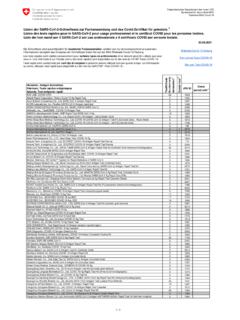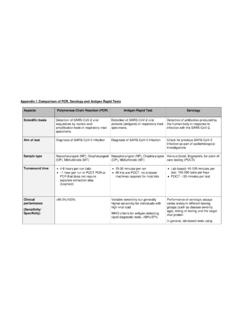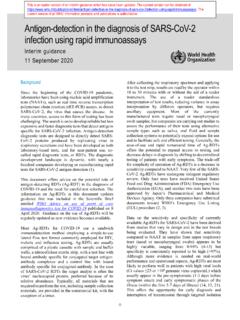Transcription of SARS - CoV - 2 (COVID19) Fact Sheet-
1 SARS- CoV- 2 (COVID-19) Fact Sheet OFFICE OF THE ASSISTANT SECRETARY FOR HEALTH Guidance Proposed Use of Point-of-Care (POC) Testing Platforms for SARS-CoV-2 (COVID-19) Overview Certain tests to detect COVID-19 may be performed at the point-of-care, or POC, meaning that the process of medical diagnostic testing occurs at the time and place of patient care, bedside, physician s office, etc. POC testing offers additional benefits including speed of diagnosis, and simplicity of use (push button, single cassette, etc.). Various types of technologies may be utilized in POC tests, such as: nucleic acid amplification (molecular) tests that detect the presence of a pathogen, antigen tests that also detect the presence of a pathogen, and serological tests that can determine whether or not an individual has immunological evidence of exposure to a pathogen. (Note that there are currently no FDA authorized serological point of care tests; however, they may become available in the future.)
2 POC tests are a useful component of the diagnostic strategy in response to the SARS-CoV-2 (COVID-19) outbreak. Nucleic Acid Amplification POC Tests Mobile platforms Mobile platforms are small and portable, and are optimal for deployment to remote, outbreak and crisis situations. These POC instruments are lower throughput ( , process fewer samples in a specified timeframe) than other platforms (instruments), and typically run one sample at a time in 5-30 minutes. For this reason, it may not be feasible to test, for example, an entire manufacturing facility of thousands of employees for COVID-19 with a POC platform. In such a situation, the POC instrument could be used to test the highest priority (symptomatic) individuals, while test orders for asymptomatic individuals could be sent out for processing at an offsite laboratory using high throughput platforms. The Abbott ID NOW is an example of a mobile molecular POC device for COVID-19. Facility-based platforms Larger POC platforms, such as the Cepheid GeneXpert Xpress, another example of a POC device that can be used for COVID-19, are often based in hospitals and medical centers.
3 They have higher throughput than the mobile platforms, but still return results in less than an hour. The components are often self-contained, requiring fewer laboratory resources ( , hands-on personnel) than other laboratory-based instruments. Using a rapid, facility-based POC platform to test healthcare providers and symptomatic patients enables maintenance of workforce (rapid return to work), reduces PPE usage, and rapid diagnosis for critically ill patients. Antigen POC tests These diagnostic tests quickly detect fragments of proteins found on or within the virus by testing samples collected from the nasal cavity using swabs. The Quidel Corporation s Sofia 2 SARS Antigen FIA received an EUA from the FDA on May 8, 2020, and is approved for point-of-care-testing by facilities operating under a CLIA Certificate of Waiver. The antigen test can provide results in minutes; however, antigen tests may not detect all active infections, based on their mechanism of action.
4 These tests are very specific for the virus, but are not as sensitive as molecular PCR tests. Therefore, positive results from antigen tests are highly accurate, but there is a higher chance of false negatives, so negative results do not rule out infection. With this in mind, negative results from an antigen test may need to be confirmed with a PCR test prior to making treatment decisions or to prevent the possible spread of the virus due to a false negative. SARS- CoV- 2 (COVID-19) Fact Sheet Serological POC Tests Currently, there are no FDA authorized COVID-19 serology point-of-care tests. This section is included to inform future planning. POC serologic testing technologies include, but are not limited to, single-use, low through-put lateral flow tests where the presence of antibody is demonstrated by a color change on a paper strip. Some samples for this type of test can be collected through the use of a fingerstick. There are different types of antibodies.
5 IgM is one of the first types of antibody to be produced after a pathogen has entered the body, and is most useful for determining recent infection. In most infections, IgG generally develops after IgM, and may remain detectable for months or years. These are the types of antibodies that are often targeted by serological tests. Whenever possible, laboratories should rely on molecular tests to diagnose the presence of SARS-CoV-2 infections. Results from antibody testing should not be used as the sole basis to diagnose or exclude SARS-CoV-2 infections or to inform infection status. CDC, NIH and FDA and other parts of the federal government are evaluating the performance of commercially manufactured antibody tests for SARS-CoV-2 (COVID-19). FDA has authorized emergency use of several of these antibody tests. It should be noted that there are many serological tests being marketed to laboratories that neither have FDA authorization, nor have they been evaluated by the FDA.
6 Presently, a positive test result from a POC serological test for SARS-CoV-2 (COVID-19) shows that an individual has antibodies that likely resulted from an infection with SARS-CoV-2, or possibly a related coronavirus. Negative results from antibody testing do not rule out SARS-CoV-2 infections, particularly for those individuals who have been exposed to the virus and are still within the estimated incubation period. It is unclear if those antibodies can provide protection (immunity) against re-infection. Appropriately validated serology tests, when used broadly as part of seroprevalence studies, can be useful in understanding how many people have been infected and how far the pandemic has progressed. These tests may also be useful to examine demographics and geographic patterns, to determine which communities may have had more cases. Proposed Uses of Point-of-Care Diagnostic Tests for SARS-CoV-2 (COVID-19) POC rapid tests are envisioned to supplement laboratory testing, enabling testing to be available for communities and populations that cannot readily access laboratory testing or need to quickly address emerging outbreaks.
7 Laboratory testing remains the primary testing mechanism for the nation because of the ability to perform a high volume of tests at one time. Examples of potential uses for POC instruments for COVID-19 diagnostic purposes include: Deployment to rural hospitals or other critical care sites that lack widely available testing. Use at public health department testing sites performing CLIA-waived testing for other purposes. Deployment to long-term care facilities or correctional institutions. Regulatory requirements and necessary CLIA documentation need to be considered when deploying instruments to these settings if they are not currently performing other POC testing. Rapid deployment to aid in the investigation of a newly identified case cluster. This potential use would require careful consideration to ensure the feasibility of rapidly standing up testing. Placement in public health laboratories to test high-priority specimens requiring a rapid result.
8 Regulatory Considerations SARS- CoV- 2 (COVID-19) Fact Sheet There are regulatory considerations that must guide the use of POC instruments for SARS-CoV-2 diagnostic purposes. Testing sites operating a POC diagnostic instrument must have a current certificate via the Clinical Laboratory Improvement Amendments of 1988 (CLIA). During the COVID-19 public health emergency, the Centers for Medicare & Medicaid Services (CMS) will permit a Certificate of Waiver laboratory to extend its existing certificate to operate a temporary COVID-19 testing site in an off-site location, such as a long-term care facility. The temporary COVID-19 testing site is only permitted to perform waived tests, consistent with the laboratory's existing certificate and must be under the direction of the existing lab director. Frequently Asked Questions (FAQs) concerning CLIA Guidance during the COVID-19 Emergency is available here. For Additional Information CDC Coronavirus Disease 2019 (COVID-19) Test for Past Infection - CDC Coronavirus Disease 2019 (COVID-19) COVID-19 Serology Surveillance Strategy CMS Frequently Asked Questions (FAQs), CLIA Guidance During the COVID-19 Emergency - FDA FAQs on Diagnostic Testing for SARS-CoV-2 - FDA Coronavirus (COVID-19) Update: FDA Authorizes First Antigen Test to Help in the Rapid Detection of the Virus that Causes COVID-19 in Patients.














